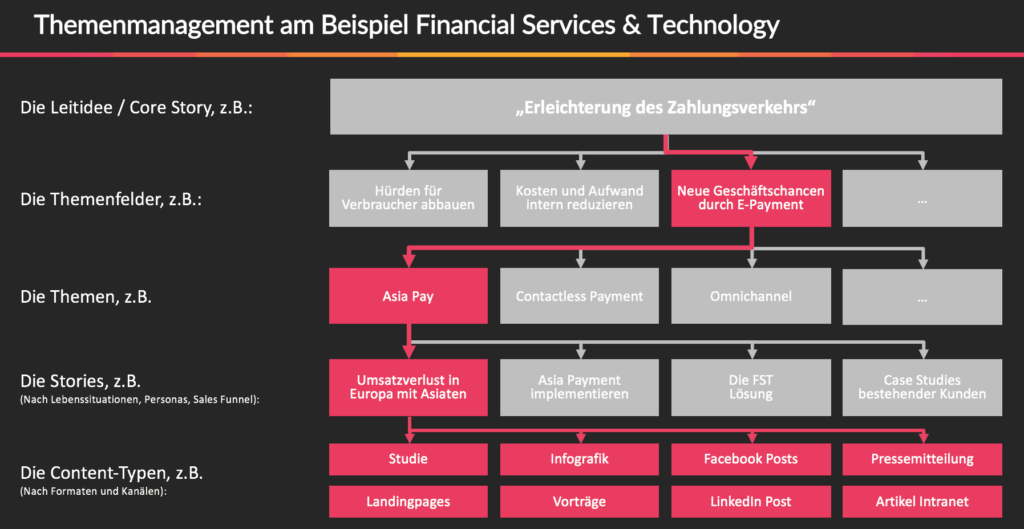
The enthusiasm for digital transformation is unbroken in the executive floors of German companies. Even internationally, almost every self-respecting manager wants to further digitalize their business, develop completely new business models and respond even better to customer needs.
One thing is clear: digitalization and the much-vaunted "customer experience" will continue to be key challenges for companies and, in particular, marketing departments and internal and external communication in 2019.
Big data. Personalization. Artificial intelligence. Messenger marketing. Mobile-first.
Many of these technical innovations are relevant, useful and promising for communication. But what about content as the actual basis of all communication? Take the financial sector, for example. When it comes to communicating products, communicating content is also important. For banks as well as insurance companies, wealth and asset managers, advice and expertise are intrinsically linked to product, sales and long-term customer loyalty.
The recently published annual report: "Digital Trends 2018 in the Financial Services Sector" shows some remarkable results in this regard.
The market barometer compiled by Econsultancy in collaboration with Adobe attests to the sector's positive starting position with regard to the quality and quantity of existing data that is generally available to it. The study also notes significant progress over the last 24 months in terms of the self-assessment of digital maturity in the companies surveyed.
So far so good.
However, according to the survey, companies in the financial services sector tend to neglect content, even though it is an essential part of their customers' quality of experience.
A quarter of the participants named the optimization of the customer experience as the area with the greatest potential for the current year and 81% rated the optimization of the customer journey as "very important".
However, companies in the financial services sector are less likely to mention the creation of compelling content for digital experiences (7% compared to 14% in other sectors). The results of the survey suggest that companies are more likely to deal with digital customer experiences as an overall concept and focus primarily on the use of new technologies.
For example, self-assessment of digital maturity rose from 9% to 17%. This indicates fundamental investment and the high importance that is attached to digitalization as a strategic topic. With regard to content, however, this central component appears to be given surprisingly little strategic importance.
The demand for high-quality customer experiences requires companies to place the customer at the center of communication and the entire business model in a new way; to play out the right content at the right time in the right format on the right channel. In particular, this also means that without content, even the most elaborate omnichannel architecture will be a yawning void. Only with relevant content can you meet customer needs in different phases of the customer journey.

Check first - then post
"Why don't you put this on Facebook quickly?" Every social media manager and every content manager has heard this phrase more than once. We like to post "agilely" and dutifully publish everything possible on the social media channels we use. Certainly with some response. However, this mechanism often forgets the following important, systematic questions:
- How do users benefit from this great posting?
- What reaction do we want to achieve?
- Which target groups are we addressing?
- What story do we want to tell? In which format?
- Is this channel even the right medium?
- Does the topic have strategic relevance for our brand?
Only content that is noticed by users, generates interest, sympathy and, if necessary, action, contributes to value creation. All other content is, at best, wasted effort or money thrown away.
How do we manage to produce targeted content that generates the desired response? It's simple: we don't just focus on the platform or channel - we focus on the message. So don't think about Facebook, website or email newsletter first, but consider the idea that is being communicated or the topic on which the brand is to be positioned. And then check exactly which channel suits this and which format is most effective for reaching customers and those who are yet to become customers.
Reading tip: From channel to story: topic management at the heart of the content marketing strategy
Investment in topic-oriented communication
Assess yourself based on your own communication practice: How many internal and external channels and media are used regularly? Can the measured KPIs be easily translated into concrete findings and actionable impulses?
The increasing demand for high-quality content that meets individual customer needs can tie up immense resources. This makes an integrated content strategy all the more important. It requires the use of technologies that enable topic-centered work across departmental boundaries and internal company silos. Without a systematic approach, content gets lost and cross-channel synergy effects remain unused.
Content production costs time and money. It has to if it is to fulfill its purpose. This is why the relationship between efficiency and use plays a central role for all types of content. Finding the right balance here embodies intelligent, flexible and future-oriented content management.
Then the unforgettable customer experiences will also work.











Comments are closed.